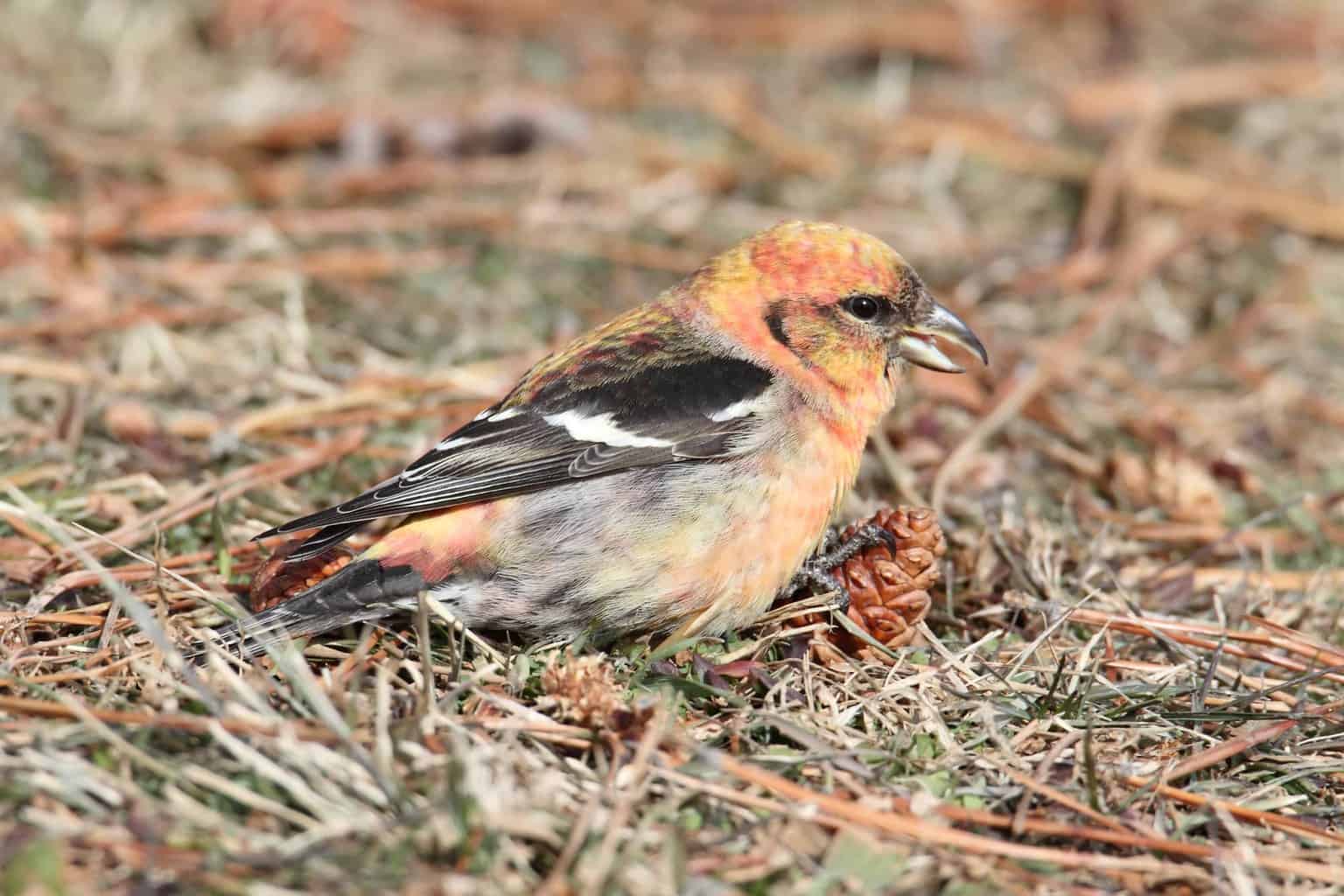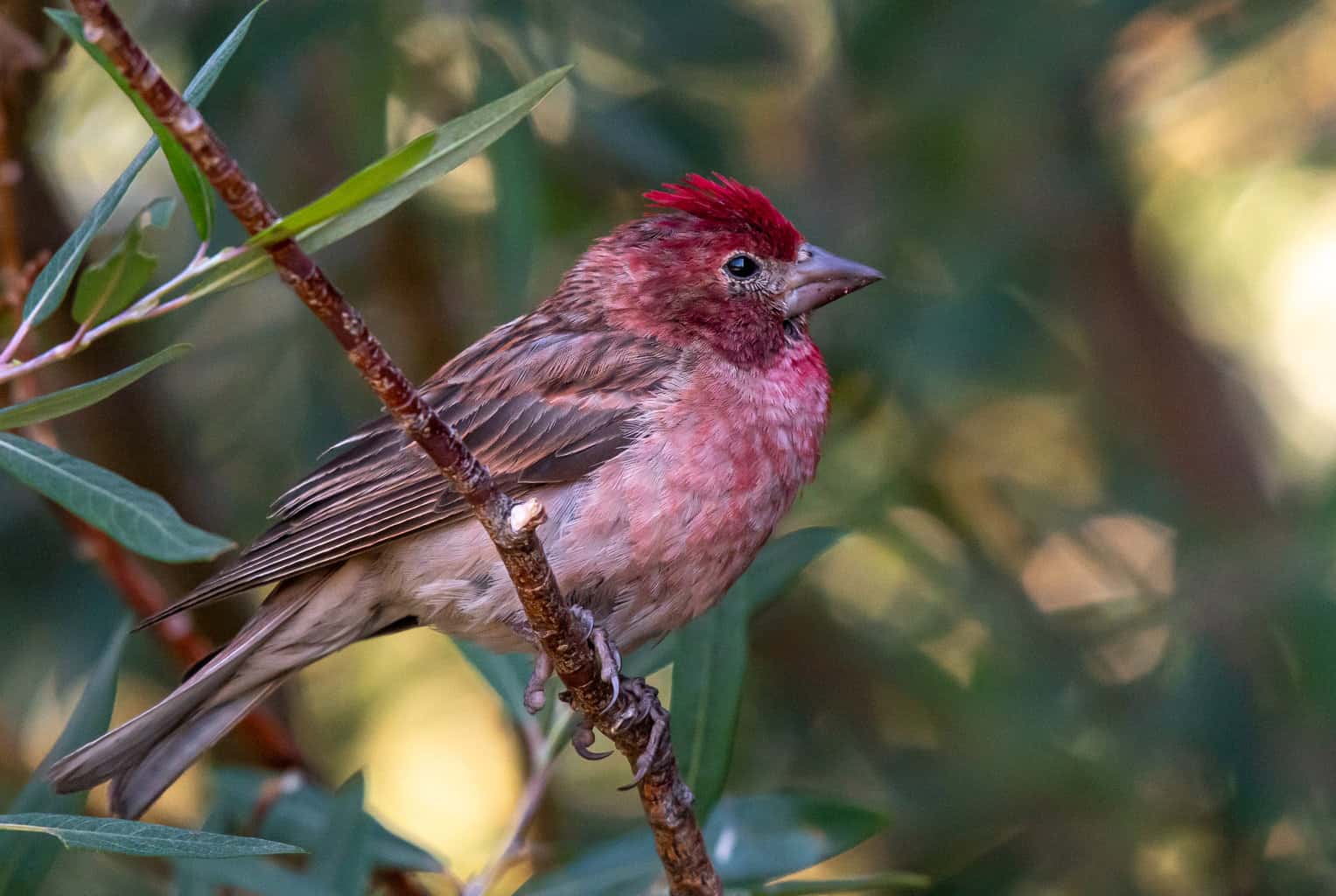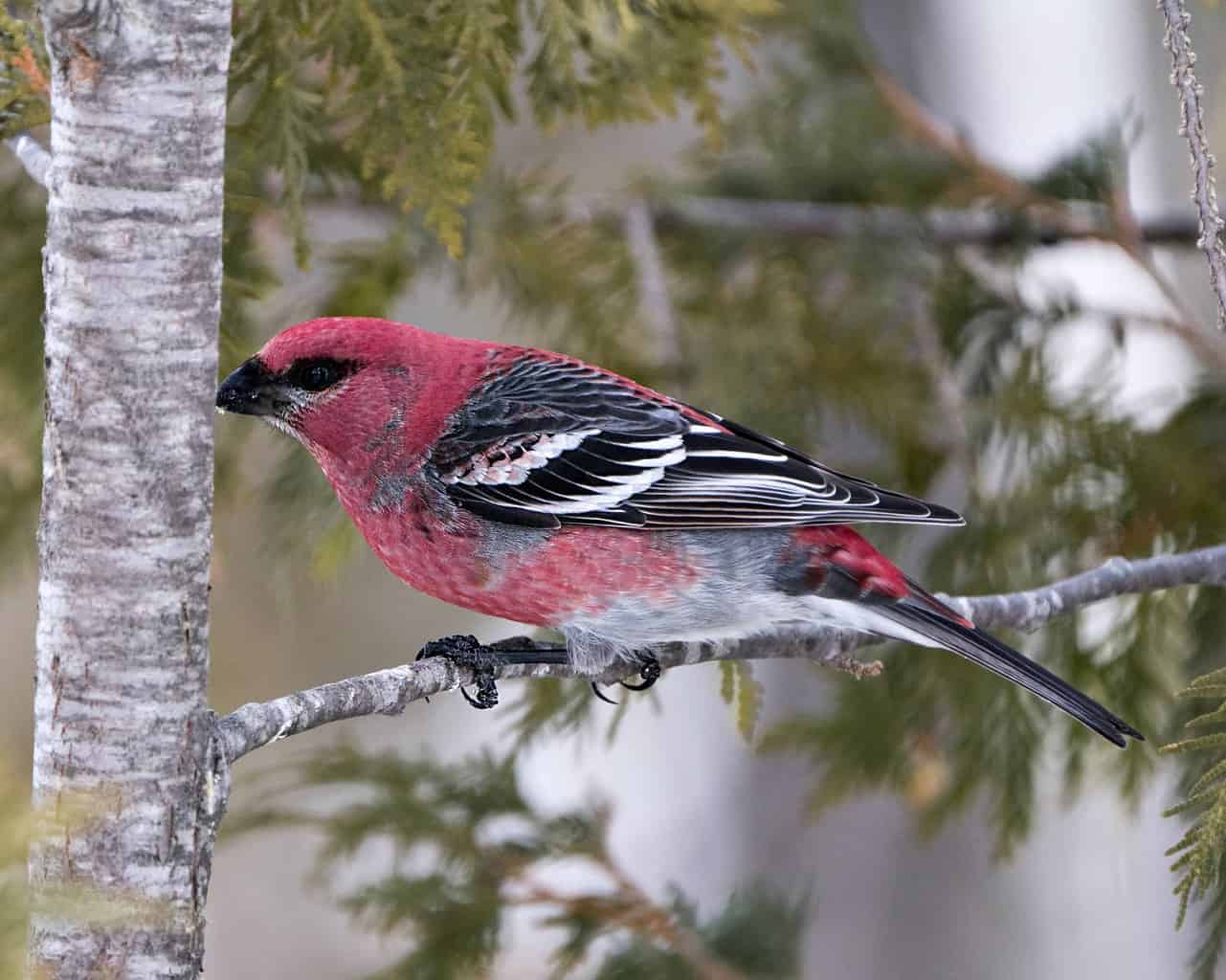The golden-breasted western meadowlark is its state bird. And yet it is only one species out of an impressive 452 in this state whose west is dominated by the Rocky Mountains.
America’s least populous state is known for its scorching days and chilly nights during summer, and even chillier winters, and is home to 16 species of finch.
If you have ever wanted to find out all about these varied and adaptable passerines, you need look no further.
In our comprehensive guide to finches in Wyoming, you will get to know just what they look like, when you are likely to see them, and where you can find them.
Brambling

- Scientific Name: Fringilla montifringilla
- Length: 6 inches
- Weight: 0.8 – 1.02 ounces
- Wingspan: 10 inches
Considered a lookalike of the chaffinch, bramblings can be recognized by their plumage which turns jet black at the head (and a speckled brown and black in winter) orange at the breast, and white at the undersurface.
Female bramblings share the same patterns and coloring although those hues are more muted in comparison to males. Their heads do not turn black in summer.
Bramblings are fall and winter visitors to the United States and may make an occasional appearance in Wyoming. They can be spotted in its southcentral, northcentral, and northwestern regions, although such occurrences are rare.
Although they generally congregate in Alaska, they may travel as far south as Colorado.
Red Crossbill

- Scientific Name: Loxia curvirostra
- Length: 7.9 inches
- Weight: 2 ounces
- Wingspan: 12 inches
This species can be recognized by the presence of plumage in males which is a beautiful copper (and may be more pronounced in some individuals compared to others) and dark wings. That copper coloring and wing pattern are also present in females, although the former is more muted and less widespread, alternating with gray.
Both genders have short, dark crisscrossed bills which they use to cleverly prise conifer, pine, or spruce cones open to get at the goodness they contain.
Red crossbills can be found in southern and western Wyoming all year long. Their year-long range throughout the United States is pretty widespread and includes western Montana, northern Idaho, and most of Washington (with the exception of its south).
White-Winged Crossbill

- Scientific Name: Loxia leucoptera
- Length: 5.7 – 6.7 inches
- Weight: 0.9 – 1.40 ounces
- Wingspan: 11 inches
Male white-winged crossbills can be recognized by their red coloring and black wings interrupted with bold splashes of white.
The plumage of their female counterparts is less striking and is grayish-brown in color with hints of bronze at their neck, head, and throat. A short dark bill is present in both males and females used for prying white spruce and hemlock cones open.
This species is especially fond of conifers (particularly spruce trees), which are not only a source of nutritious cones but also a source of shelter for nesting.
Although they prefer to remain in Alaska and most of Canada (with the exception of Nunavut), they may also wander as far south as Colorado. As a result, white-winged crossbills can be found all year long throughout Wyoming, albeit in low numbers.
Cassin’s Finch

- Scientific Name: Haemorhous cassinii
- Length: 6 inches
- Weight: 0.8 – 1.2 ounces
- Wingspan: 10 – 11 inches
Male Cassin’s finches can be recognized by a short tuft of red feathers on their crowns, and a head flushed with pink with dashes of brown. Their chests are covered in brown stripes against pale fur with hints of pink, while their wings are brown.
Females exhibit more prominent streaking on their chests and are generally brown at the head, wings, and upper surfaces.
Cassin’s finches prefer to live in coniferous and deciduous forests containing aspen, fir, pine, and spruce. Although they can be found in the western half of Wyoming throughout the year, they may also be found in its eastern half, albeit in lower numbers.
Cassin’s finches can also be found in western Montana, throughout Idaho, and most of Oregon and Washington.
House Finch

- Scientific Name: Haemorhous mexicanus
- Length: 6 inches
- Weight: 0.6 – 0.9 ounces
- Wingspan: 10 inches
Male house finches’ distinguishing features include prominent pink coloring (blended with brown) at the head and chest and brown stripes against a pale background at the chest and undersurface.
Females on the other hand are generally paler, especially at the head and chest, and exhibit the same striated pattern on their chests and ventral surfaces.
House finches are at home in forests of pine, spruce, and aspen as well as shrubland containing chokecherry, greasewood, juniper, mountain mahogany, and sagebrush.
This especially adaptive species can be found throughout Wyoming all year round. Its range also includes the entirety of the United States with the exception of Florida’s southernmost tip and most of Texas’ coast.
Purple Finch

- Scientific Name: Haemorhous purpureus
- Length: 4.7 – 6.3 inches
- Weight: 0.63 – 1.10 ounces
- Wingspan: 10 inches
The heads of male purple finches are mostly pink while their pale chests and brown wings and tails are flushed with rose. Females are a dull brown with more prominent streaking against a pale background at the chest.
Although purple finches are absent from Wyoming in summer, they may visit during winter and may be found throughout the state.
The species is also present along the Pacific Coast from Washington in the north to California in the south. While conspicuously absent from central states, it can also be found in Michigan and New York.
Evening Grosbeak

- Scientific Name: Hesperiphona vespertina
- Length: 6 – 9 inches
- Weight: 1.3 – 3.0 ounces
- Wingspan: 12 – 14 inches
Male members of this species are pretty striking with their plumage which is dark at the head with a prominent yellow bar over their dark eyes. This somber coloring lightens to bronze at the throat and nape and then to dark yellow at the breast and undersurface. Their wings, however, are thickly white-edged with black.
Evening grosbeaks can be found in northwestern Wyoming, all year round. They may also be seen infrequently during all seasons in its western region and in its northeastern region.
These birds which are known to be especially fond of sunflower seeds and box elders can also be found all year round across Canada from British Columbia in the west to Quebec in the east.
Pine Grosbeak

- Scientific Name: Pinicola enucleator
- Length: 8 – 10 inches
- Weight: 2 – 3 ounces
- Wingspan: 13 inches
Male pine grosbeaks are covered in plumage which is mostly red but which turns black and white at the wings and brown at its divided tail. The coloring of their female counterparts is more muted and tends towards a gray-brown with a slight flush of bronze at the chest.
Pine grosbeaks enjoy a varied diet consisting of berries, crabapples, pine cones, insects, and even sunflower seeds. They are particularly fond of crabapple, birch, juniper, maple, mountain ash (rowan), and spruce.
Although they are not abundant in Wyoming, they can be spotted throughout the state, all year round. However, breeding populations can be found in Alaska, Canada, as well as Washington, Oregon, California, and even Arizona, in the southwest.
Lawrence’s Goldfinch

- Scientific Name: Spinus lawrencei
- Length: 5.5 inches
- Weight: 0.4 – 0.7 ounces
- Wingspan: 8 – 9 inches
This small finch can be recognized by a black mask, pale head feathers and beak, a yellow breast, and wing and tail feathers which are colored in uneven layers of yellow and black.
Female members of the species lack the male’s characteristic black mask and have a more muted yellow at the chest.
This species is only very rarely spotted in the southeastern part of the state and is mostly found in western and central California as well as Mexico to the south. It may also be found in Arizona and New Mexico.
Lesser Goldfinch

- Scientific Name: Spinus psaltria
- Length: 3.5 – 4.7 inches
- Weight: 0.3 – 0.4 ounces
- Wingspan: 6 – 11 inches
A smaller relative of the American goldfinch, the lesser goldfinch shares the same black cap, golden coloring, and barred wing and tail feathers as its larger cousin.
However, its upper surface may also be black or olive, rendering it less radiant than the American goldfinch. Female birds are colored olive and brown with hints of yellow.
The lesser goldfinch, which is actually considered to be the smallest variety of finch, is equally at home in arid areas and pine forests and prefers to stay close to sources of water.
Although this species is rarely found in Wyoming, it may be spotted throughout the state during spring and autumn migrations. However, it breeds in Arizona, Colorado, New Mexico, and Utah to the south. The lesser goldfinch can also be found all year round in western California and Oregon, southwestern Texas, and Mexico.
Gray-Crowned Rosy Finch

- Scientific Name: Leucosticte tephrocotis
- Length: 5.5 – 6.3 inches
- Weight: 0.8 – 2 ounces
- Wingspan: 13 inches
Males of this species can be recognized by a black mask which fades to gray on the rest of the head. From the throat and nape, that gray turns to brown which covers the body entirely except for flashes of pink at the undersurface and the wings.
Females have a somewhat similar coloring without the black mask. The wings of both genders are barred brown and black.
Gray-crowned rosy finches can be found throughout Wyoming throughout the year. They may also be found in Montana, Idaho, Washington, and Oregon, in the same capacity.
However, they generally appear more frequently throughout the year in British Columbia, southern Alberta, and eastern California, all year round.
Black Rosy Finch

- Scientific Name: Leucosticte atrata
- Length: 5.5 – 6.3 inches
- Weight: 0.8 – 1.10 ounces
- Wingspan: 13 inches
Black rosy finches are covered in bronze-colored feathers with hints of pink which lighten to gray at their heads. They also have black masks on their faces which may extend to the crown. Their wing feathers are black-edged with white.
They can frequently be found in northwestern Wyoming all year round. However, their range within the state also extends eastwards and southwards in a density that decreases at its easternmost limit. They are absent from the northeastern part of the state.
Black rosy finches can also be found in central Idaho, although their range extends to the southern and eastern parts of the state. They can also be found in Oregon’s southeastern extremity and in Colorado, Nevada, New Mexico, and Utah.
Brown-Capped Rosy Finch

- Scientific Name: Leucosticte australis
- Length: 6.6 inches
- Weight: 0.8 – 1.10 ounces
- Wingspan: 9.4 inches
These rather compact birds are covered in plumage which is dark brown at the crown and which lightens to a rather milk chocolate hue on the upper surface and chest. That brown gives way to a pale pink at the undersurface, switching to an even darker brown edged with white at the wings.
Brown-capped rosy finches have a preference for meadows, pastures, and even cliffs (where they breed) and can be found in southeastern Wisconsin all year round.
Members of these species can also be found in central and western Colorado and northern and western New Mexico all year round.
Common Redpoll

- Scientific Name: Acanthis flammea
- Length: 4.5 – 5.5 inches
- Weight: 0.4 – 0.6 ounces
- Wingspan: 8 – 9 inches
Small, nimble, and possessing a remarkable ability to withstand the cold, common redpolls exhibit a red patch at the crown and a flush of red on their pale breasts. Their plumage is also striated with brown streaks while their wing feathers are edged with white.
Members of this species prefer the buds, flowers, and seeds of alders, birches, and willows. They also have a handy pouch in which to tuck away copious quantities of food to digest at leisure, safe from inclement weather.
These beautiful small avians are winter visitors to Wyoming and can be found in open prairie, shrubland, and urban areas, all over the state, in low numbers.
Common redpolls generally breed in northern Alaska, Yukon, the Northwest Territories, and Quebec. Although they may be found in northern Canada throughout the year, they may also travel as far south as Nevada and Colorado.
Hoary Redpoll

- Scientific Name: Acanthis hornemanni
- Length: 5 – 5.5 inches
- Weight: 0.40 – 0.50 ounces
- Wingspan: 8 – 10 inches
The plumage of male members of this frost-tolerant species is dark red at the crown and a beautiful pale gray covered in slightly darker streaks elsewhere with a slight pink flush at the face and chest.
Female birds also exhibit the same dark red coloring at the crown however their pale streaked plumage has none of the pink flush found in males. Both genders have darker wing and tail feathers edged with white.
This species is especially fond of alder, birch, and willow trees, and breeds at the northern fringes of Alaska, Yukon, and the Northwest Territories from May to July. Its members are impressively hardy and may even brave the plummeting winter temperatures of the tundra, on occasion.
Hoary redpolls are rarely found in Wyoming but, however, may occasionally visit during winter and may be spotted in the northern part of the state.
Pine Siskin

- Scientific Name: Spinus pinus
- Length: 4.3 – 5.5 inches
- Weight: 0.4 – 0.6 ounces
- Wingspan: 7 – 9 inches
This small-sized bird can be recognized by its plumage which is pale and covered in brown streaks. The wings of the pine siskin are edged with yellow and hints of the same color also appear beneath its tail.
Its favorite foods include the flowers and seeds of alders, birches, and spruce. It is also fond of nectar, grubs, and insects.
The pine siskin can be found throughout Wyoming all year round, in deciduous and coniferous forests. It can also be found in areas close to sources of water where cottonwood, fir, and spruce grow, as well as in urban areas.
The species breeds in Canada although its range extends throughout the United States and as far south as Mexico.
Conclusion
From the surprisingly hardy hoary redpoll capable of enduring especially harsh winters to the impressively adaptable house finch, Wyoming is home to a varied selection of these colorful passerines, none of which are the same.
Several of them are especially fond of backyard bird feeders and might visit your garden for sunflower seeds and suet and some species such as the common redpoll might even tolerate a bit of respectful curiosity.
Wyoming’s finches can also be viewed while admiring unspoiled nature. Cassin’s finches, red crossbills, and pine grosbeaks can be seen in coniferous forests in Yellowstone Park. Black-headed grosbeaks and pine siskins, on the other hand, can be seen in Grand Teton Park.
The next natural step on your adventure is finding out more about the many beautiful birds in Wyoming. All so you can get to know the amazing avian species that call the Equality State home.

